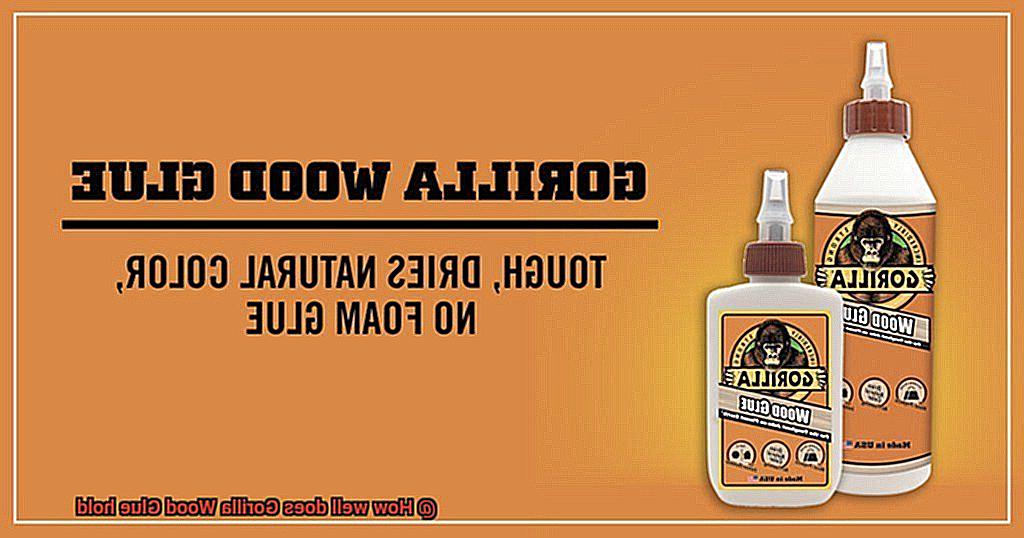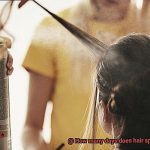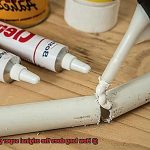Today, we’re diving headfirst into the world of Gorilla Wood Glue to uncover its mind-blowing holding power and see if it lives up to its mighty reputation. If you’ve ever wondered just how well Gorilla Wood Glue stands the test of time, you’ve come to the right place.
Picture this: you’ve poured your heart and soul into creating a jaw-dropping wooden masterpiece, only to have it crumble like a stale cookie because of weak adhesive. Talk about a major bummer. Luckily, Gorilla Wood Glue has swooped in like a knight in shining armor for woodworkers all over the globe, promising an unyielding grip and an everlasting bond that can withstand anything.
But does it really live up to the hype? Let’s dig deep into the nitty-gritty details and find out why this glue has become the holy grail for craftsmen and DIY enthusiasts.
Gorilla Wood Glue boasts an insanely strong adhesive formula that was tailor-made for wood. It thrives under pressure, working tirelessly to create a bond that’s practically indestructible. So whether you’re bonding tiny wooden components or tackling massive construction projects, this glue has got your back with its exceptional hold and resistance to moisture, solvents, and even wild temperature swings.
One thing that sets Gorilla Wood Glue apart from the rest is its extended working time. Unlike those other adhesives that dry up faster than a puddle in the desert sun before you can even align your pieces perfectly, this glue gives you ample time to get things just right. No more rushing against the clock. And when it dries up, it blends seamlessly with the natural color of wood for a flawless finish.
But here’s where things get really exciting: Gorilla Wood Glue isn’t just for indoor projects. Nope, it’s got your back even when you’re taking on the great outdoors. That’s right, this adhesive is a reliable sidekick for tasks that involve facing off against the elements. From wooden furniture and cabinetry to flooring and outdoor structures, Gorilla Wood Glue is engineered to endure and keep your creations rock-solid for years to come.
So, does Gorilla Wood Glue truly hold its ground? Stick around as we embark on a thrilling adventure, testing its strength against different wood
Benefits of Gorilla Wood Glue
Contents
- 1 Benefits of Gorilla Wood Glue
- 2 Types of Woods for Gorilla Wood Glue
- 3 Surface Preparation for Gorilla Wood Glue
- 4 Application Techniques for Gorilla Wood Glue
- 5 Clamping and Curing Process for Gorilla Wood Glue
- 6 Environmental Factors Affecting the Performance of Gorilla Wood Glue
- 7 Advantages of Using Gorilla Wood Glue
- 8 Disadvantages of Using Gorilla Wood Glue
- 9 Conclusion
When it comes to woodworking projects, choosing the right adhesive is crucial for ensuring a durable and long-lasting bond between wood surfaces. Among the many options available, Gorilla Wood Glue stands out for its exceptional strength, versatility, and reliability. In this article, we will explore the numerous benefits of using Gorilla Wood Glue in your woodworking projects.
Exceptional Bonding Strength:
- Gorilla Wood Glue is known for its remarkable bonding strength, creating a robust connection between wood surfaces.
- It can withstand heavy-duty applications, making it suitable for joining large pieces of wood or repairing furniture with confidence.
Water-Resistant Properties:
- Gorilla Wood Glue is specifically designed to be water-resistant, making it ideal for projects exposed to moisture and humidity.
- Even when placed outdoors or in contact with water occasionally, the bond remains strong and intact.
Clear Drying:
- Gorilla Wood Glue dries clear, ensuring that the bond is not visible after application.
- This feature allows for seamless integration into the overall design and guarantees a professional finish.
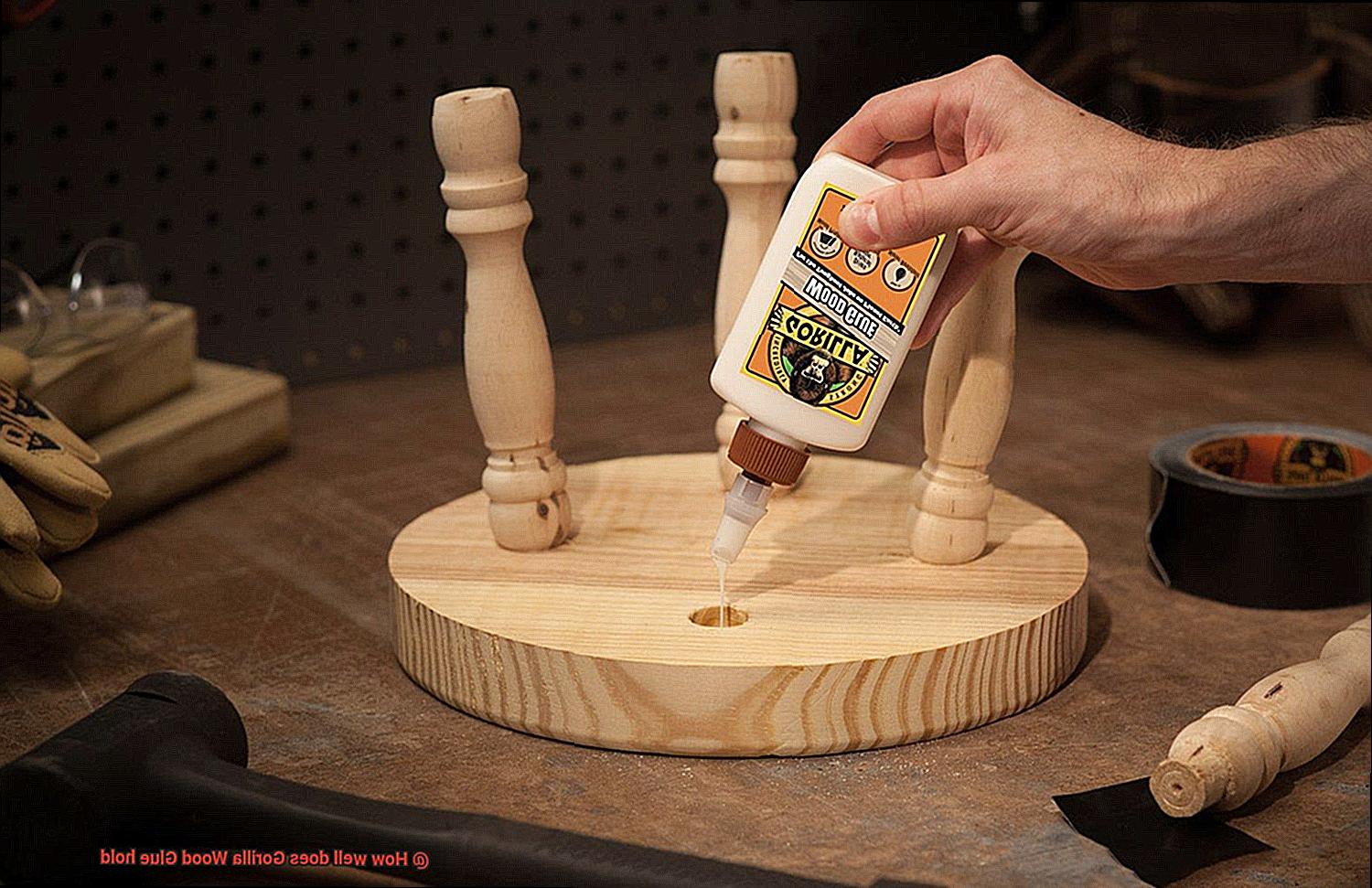
Versatility on Various Wood Types:
- Gorilla Wood Glue is highly versatile and compatible with different wood types, from hardwoods to softwoods and engineered wood products.
- Regardless of your project’s requirements, you can trust that this glue will deliver excellent results.
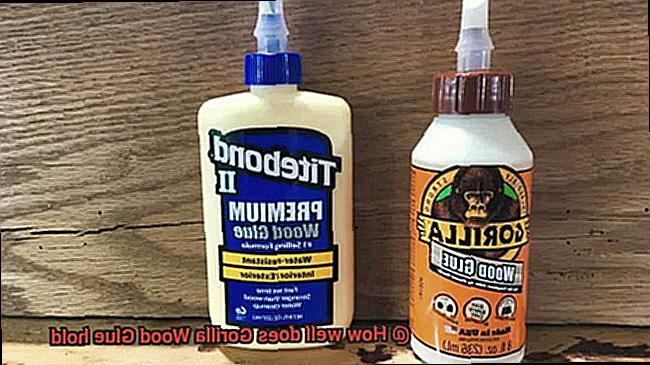
Fast Drying Time:
- Gorilla Wood Glue has a relatively fast drying time, minimizing waiting periods and allowing you to proceed with your project without unnecessary delays.
- However, sufficient drying time should be allowed for maximum bond strength.
No Clamping Required (in most cases):
- Unlike some other wood glues, Gorilla Wood Glue does not require clamping in most cases.
- This convenience allows you to apply the glue and leave it to dry without the need for external pressure or support.
- For optimal results, it is recommended to apply clamping pressure for 20-30 minutes during the curing process.
Non-Toxic and Safe:
- Gorilla Wood Glue is non-toxic when dry, ensuring safety during and after application.
- This feature makes it suitable for use in projects involving children or pets.
- However, proper handling and storage should be followed as per the manufacturer’s instructions.
Various Sizes and Applicator Options:
- Gorilla Wood Glue offers a range of sizes and applicator options to cater to different project requirements.
- Whether you need a small bottle for quick repairs or a larger container for extensive woodworking projects, there is a suitable option available.
Types of Woods for Gorilla Wood Glue
Woodworking is a skill that requires not only talent but also the right tools and materials. One essential tool in every woodworker’s repertoire is Gorilla Wood Glue, known for its strong bond and versatility.
However, not all woods are compatible with this powerful adhesive. Let’s explore five different types of woods that work best with Gorilla Wood Glue and understand why they are a perfect match.
Softwoods – Pine, Fir, Cedar, and Spruce:
Softwoods are the bread and butter of woodworking projects. They are lightweight, easy to work with, and perfect for crafting furniture or building wooden toys. Gorilla Wood Glue loves softwoods because they have a porous nature that allows the glue to penetrate deep into the wood fibers. This ensures a strong bond that will withstand the test of time. Whether you’re making a rustic pine bookshelf or a cedar chest, Gorilla Wood Glue will hold it all together.
Hardwoods – Oak, Mahogany, Maple, and Cherry:
Hardwoods are the heavyweights of the woodworking world, known for their durability and beauty. While bonding hardwoods can be more challenging due to their high density and tight wood grain structure, Gorilla Wood Glue rises to the occasion. With proper surface preparation and clamping techniques, this adhesive can form a solid bond on hardwoods as well. So whether you’re crafting an elegant oak dining table or a mahogany jewelry box, trust Gorilla Wood Glue to keep your creations intact.
Exotic Woods – Teak, Rosewood, and Ebony:
Exotic woods bring a touch of luxury to any woodworking project. However, their natural oils and resins can present a challenge when it comes to bonding with Gorilla Wood Glue. To achieve a successful bond, it’s crucial to thoroughly clean and degrease the surfaces of exotic woods before applying the adhesive. With extra care and attention, Gorilla Wood Glue can help you create stunning pieces with these unique woods, whether it’s a teak outdoor bench or a rosewood guitar.
Engineered Woods and Composites:
Engineered wood products like plywood and particleboard are widely used in construction and furniture making. Gorilla Wood Glue is designed to bond with various types of wood, including engineered woods. However, it’s important to check the manufacturer’s instructions to ensure compatibility with specific engineered wood products. Some composites may have moisture-resistant properties or finishes that can hinder the glue’s effectiveness. By following the guidelines, you can achieve a solid bond on these materials as well.
Surface Preparation for Gorilla Wood Glue
Today, we delve into the crucial topic of surface preparation when using Gorilla Wood Glue. Just as a strong foundation is essential for a sturdy building, proper surface preparation is the key to achieving a durable bond with this remarkable adhesive. So, let’s roll up our sleeves and learn how to prepare surfaces like seasoned professionals.
Step 1: Cleanliness is Next to Bond-iness
Before applying Gorilla Wood Glue, ensure that the surfaces you’re bonding are clean and free from any contaminants. Use a clean cloth or brush to remove dirt, dust, grease, or other unwanted particles. Remember, a clean surface allows for better adhesion and ensures a solid bond.
Step 2: Smooth Operator
Smooth surfaces provide better contact between the glue and the materials being bonded. Grab some sandpaper and gently sand away any rough edges or imperfections. This will create an even surface, resulting in a stronger bond. As you smooth out the surfaces, envision the seamless connection that awaits.
Step 3: Wipe Out Moisture Worries
Moisture can be the nemesis of effective bonding. Make sure your materials are dry before applying Gorilla Wood Glue. If they’re damp or wet, allow them to dry completely. This step ensures that the adhesive can do its job without any interference. Bid farewell to moisture worries and embrace the dryness that leads to success.
Step 4: Priming for Success
For porous materials like unfinished wood, priming or sealing is highly recommended. This preventive measure prevents excessive absorption of the glue into the material and enhances the strength of the bond. A little preparation goes a long way. Prime your surfaces with care and lay the foundation for an unbreakable bond.
Step 5: Adhesive Application
Now that your surfaces are prepped and ready, it’s time to apply Gorilla Wood Glue. Follow the manufacturer’s instructions carefully. Apply a thin and even layer of glue to one of the surfaces being bonded, covering the entire area that will come into contact with the other surface. Avoid excess glue, as it can weaken the bond. Let the adhesive flow like an artist’s brushstroke.
Step 6: Pressing Matters
Join the surfaces together firmly and evenly. Apply pressure using clamps or other suitable methods to ensure good contact between the surfaces. The recommended clamping time varies based on factors such as material type, temperature, and humidity. Always refer to the manufacturer’s instructions for specific guidelines. Embrace the power of pressure and witness the bond take hold.
Application Techniques for Gorilla Wood Glue
When it comes to woodworking projects, having a reliable adhesive is crucial for creating strong and durable bonds. Enter Gorilla Wood Glue, a go-to choice for craftsmen and DIY enthusiasts alike. But how do you ensure that you’re getting the most out of this powerful adhesive? In this guide, we’ll walk you through the essential application techniques that will help you achieve an unbreakable bond with Gorilla Wood Glue.
Preparation is Key:
Before applying Gorilla Wood Glue, proper surface preparation is essential. Make sure the surfaces you plan to bond are clean, dry, and free from any dust or debris. Take a moment to wipe away loose particles using a clean cloth or brush. Trust us; this simple step can make a world of difference in the strength of your final bond.
Application Technique:
Now that your surfaces are prepped and ready, it’s time to apply the glue. For larger projects, such as furniture assembly or woodworking projects, consider using a brush or roller to evenly spread the glue over one of the surfaces. If you’re working on smaller applications, a nozzle or spreader can do the trick. Regardless of the tool you choose, aim for a thin and even layer that covers all areas.
Press and Hold:
With the glue applied, it’s time to bring the two surfaces together. Apply firm pressure to ensure maximum contact between the glued surfaces. For added assurance, use clamps or weights to hold the pieces together while the glue dries. The curing time will depend on factors like temperature and humidity, so make sure to follow the manufacturer’s instructions for optimal results.
Tidy Up:
Sometimes excess glue will squeeze out from the bond. Don’t panic. Simply grab a damp cloth or sponge and wipe away any excess glue immediately. If you let it dry, removing it becomes more challenging and may leave behind unwanted residue.
Safety First:
Gorilla Wood Glue is water-based and non-toxic, making it safe to use. However, it’s always wise to take basic safety precautions. Wear gloves and eye protection while handling the glue, and ensure proper ventilation in your workspace.
Expert Tips:
For the best results, follow the manufacturer’s instructions carefully. They may provide specific recommendations for different types of wood or project requirements. Additionally, if you plan to use Gorilla Wood Glue for outdoor projects exposed to moisture or extreme weather conditions, consider sealing or waterproofing the bond for added protection.
Clamping and Curing Process for Gorilla Wood Glue
Today, we delve into the essential processes of clamping and curing that ensure your woodworking projects stand the test of time. Think of them as the dynamic duo that guarantees unbreakable bonds. So, let’s arm ourselves with knowledge and plunge into the realm of clamping and curing with Gorilla Wood Glue.
Clamping is like giving your bond a bear hug. It’s all about applying pressure to bring the glued surfaces together. This step is crucial because it maximizes the strength of your adhesive. By exerting pressure, you create better contact between the glue and the wood, resulting in a robust bond. After all, who wants a feeble joint?
To achieve effective clamping, you’ll need reliable tools by your side. For larger projects, bar or pipe clamps are your best allies. Their mighty force holds everything in place until the glue dries. Smaller projects can get by with spring clamps or even trusty rubber bands. Choose your clamps wisely, considering the size and shape of your endeavor.
Before you embark on gluing, perform a dry-fit to ensure perfect alignment. Once satisfied, apply a thin layer of Gorilla Wood Glue evenly on both surfaces. Now it’s time for the magic to unfold.
While clamping, keep an eye out for any excess glue that may squeeze out. We don’t want it tarnishing our finishing process. Simply wipe away any surplus with a damp cloth or sponge before it hardens. But be careful not to disturb the position of your clamped pieces while doing so.
Now that our pieces are securely clamped together, patience becomes our ally. Curing refers to the time required for the glue to dry and harden fully. For Gorilla Wood Glue, a 24-hour cure is generally recommended for maximum strength. However, don’t despair. You’ll start witnessing the bonding power within a shorter period.
While the glue cures, resist the temptation to touch or move your clamped pieces prematurely. Any premature movement can weaken the joint, jeopardizing the reliability of the bond. So, sit back, relax, and let Gorilla Wood Glue work its magic.
One last thing to keep in mind: Gorilla Wood Glue is water-based. This means it requires moisture to cure properly. If you’re bonding non-porous surfaces or using dense hardwoods, dampening one or both surfaces before applying the glue can activate the curing process and enhance adhesion.
Environmental Factors Affecting the Performance of Gorilla Wood Glue
In the world of woodworking, a strong bond is the backbone of every successful project. Enter Gorilla Wood Glue, the hero adhesive renowned for its unbeatable performance. However, what many may not realize is that environmental factors hold the key to unlocking the true potential of this extraordinary glue. In this captivating blog post, we delve into the mesmerizing realm of temperature, humidity, surface preparation, pressure and clamping, substrate type, and exposure to water – all of which can significantly impact the performance of Gorilla Wood Glue.
Temperature:
Just like Goldilocks searching for the perfect porridge, Gorilla Wood Glue craves the sweet spot. Extreme temperatures can throw it off balance. When it’s too cold, bonding may take an agonizingly long time, leaving you tapping your fingers impatiently. Conversely, if it’s too hot, this superhero glue dries in a flash, leaving little time for a proper bond to form.
Humidity:
Humidity is the yin to Gorilla Wood Glue’s yang. High humidity slows down drying and curing times, granting you extra moments for those intricate projects that require meticulous attention. On the other hand, low humidity spells trouble. The glue may dry too fast, compromising its ability to create a robust and unyielding bond.
Surface Preparation:
Picture this – you’re about to apply Gorilla Wood Glue onto a surface covered in dust or grease. Hold your horses. Proper surface preparation is paramount in unleashing the full potential of this adhesive marvel. Cleanliness reigns supreme; ensure surfaces are impeccably dry and free from any contaminants for optimal adhesion and an unbreakable bond.
Pressure and Clamping:
Imagine applying Gorilla Wood Glue without giving it a bear hug. Applying the right pressure and using clamps during the drying process ensures even adhesive spread and enhances contact between materials. This dynamic duo prevents any sneaky movement or shifting while the glue cures, ensuring the bond is as steadfast as can be.
Substrate Type:
Not all woods are created equal, and Gorilla Wood Glue knows that too well. Each wood species boasts its own porosity and density, influencing how effectively the glue penetrates and adheres. Understanding the unique characteristics of the substrate is essential for achieving exceptional results that withstand the test of time.
Exposure to Water:
Once fully cured, Gorilla Wood Glue becomes a water-resistant warrior. However, continuous exposure to water or high humidity can gradually weaken the bond over time. Take into account the intended use and environment to ensure long-lasting strength that resists even the harshest aquatic challenges.
Advantages of Using Gorilla Wood Glue
This powerful adhesive is specifically designed for bonding wood to wood, making it an essential tool for any woodworking project. Let’s explore the advantages of using Gorilla Wood Glue and why it should be a staple in your workshop.
First and foremost, Gorilla Wood Glue is renowned for its exceptional holding power and strength. It forms a permanent bond that can withstand heavy loads and stress, ensuring durable finishes that stand the test of time. Say goodbye to weak joints and hello to a sturdy masterpiece.
But what sets Gorilla Wood Glue apart from other wood glues on the market? One major advantage is its fast-setting time. No more waiting around for glue to dry – Gorilla Wood Glue sets quickly, allowing you to spend more time working on your project. Say goodbye to wasted minutes and hello to efficiency.
Another standout feature of Gorilla Wood Glue is its water resistance. Unlike some other glues that break down when exposed to moisture, Gorilla Wood Glue remains strong and reliable. Rain or shine, indoor or outdoor, this glue has got you covered. No need to worry about changes in temperature or humidity compromising your hard work.
Speaking of peace of mind, you’ll be glad to know that Gorilla Wood Glue has a non-toxic formulation. You can use it in enclosed spaces or areas with limited ventilation without worrying about strong odors or respiratory issues. Your safety is paramount, and Gorilla Wood Glue takes that seriously.
But wait, there’s more. Gorilla Wood Glue is also incredibly versatile. It can be used on various types of wood, including hardwoods, softwoods, and even composite woods. No matter the project at hand, this glue is up for the challenge. Plus, it dries with a natural color that seamlessly blends with most types of wood, leaving you with a clean and professional finish.
Last but not least, Gorilla Wood Glue is readily available and affordable. You can find it at most hardware stores or online retailers without breaking the bank. Accessibility and affordability are key factors to consider when choosing a glue for your woodworking projects, and Gorilla Wood Glue checks both boxes.
Disadvantages of Using Gorilla Wood Glue
When it comes to woodworking projects, choosing the right adhesive is essential for creating strong and durable bonds between wood pieces. One popular option on the market is Gorilla Wood Glue. While this glue offers numerous advantages, it’s important to be aware of its disadvantages before diving in headfirst.
One major drawback of Gorilla Wood Glue is its long drying time. Unlike some other wood glues that can dry within a few hours, Gorilla Wood Glue typically takes around 24 hours to fully cure. This can be highly inconvenient for projects that require quick assembly or immediate use. If you’re looking for a glue that allows you to move forward with your project faster, it may be wise to explore other options.
Another downside of Gorilla Wood Glue is its thick consistency, which can make it messy to work with. The glue may drip or run, particularly when applying it vertically or in tight spaces. This can result in excess glue seeping out and leaving unsightly residue on the surface. If you’re working on a project that requires precision and clean lines, you may find the thickness of this glue to be a disadvantage.
Furthermore, Gorilla Wood Glue is specifically formulated for wood bonding and is not suitable for use on other materials such as plastics or metals. Attempting to use it on surfaces other than wood may lead to weak adhesion or even damage. If you’re searching for a versatile adhesive that can be used on various materials, you’ll need to explore alternative options.
Unlike some other wood glues, Gorilla Wood Glue does not have gap-filling capabilities. It is designed for joining clean and well-fitting surfaces together. If there are gaps or unevenness in the wood pieces being glued, additional measures such as clamping or filling may be required for a strong bond. This can add extra time and effort to your project, making it less efficient.
In terms of application, one of the downsides of Gorilla Wood Glue is its strong odor. The smell can be unpleasant and bothersome during use, so it’s recommended to have proper ventilation when working with this glue to prevent any discomfort or respiratory issues.
Lastly, the price of Gorilla Wood Glue is higher compared to some other wood glues on the market. While the quality and strength of the adhesive are often praised, the cost may deter budget-conscious individuals or those who do not require the specific characteristics of this glue.
v9lVNMLz2FU” >
Also Read: Is Gorilla Super Glue Waterproof?
Conclusion
Gorilla Wood Glue is a true champion when it comes to holding wood together.
Its grip is incredibly strong, ensuring that your projects stay intact for years to come. Whether you’re working on a small craft or tackling a big woodworking project, this glue has got your back.
It bonds quickly and securely, creating a bond that is as solid as a rock. You won’t have to worry about your pieces coming apart or losing their strength over time.
Gorilla Wood Glue truly lives up to its name, proving time and time again that it’s the go-to choice for any woodworking enthusiast.

